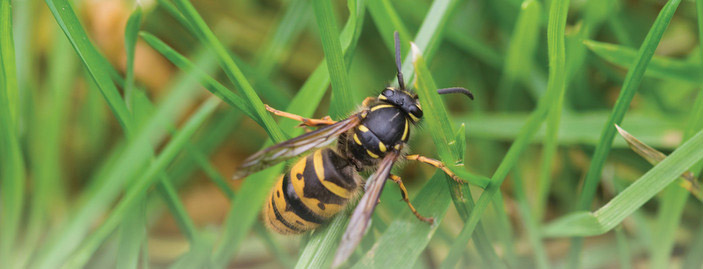The Nature of Yellowjackets

By Kerry Brosnan, 2022 VHCB AmeriCorps Conservation Technician
I was eating brunch outside with friends when an unexpected visitor came to our table. Buzzing, yellow, and black, an Eastern Yellowjacket (Vespula maculifrons) charged right at us. Friends began to squeal. Instead of running away in a panic, I calmly watched to learn why this yellowjacket was so interested in us and our leftover chicken and waffles.
Having just taken NBNC’s Biodiversity University course on wasps, I explained my newfound fascination to my friends and encouraged them to let the wasp do its thing. The yellowjacket headed straight for the hunk of leftover chicken and spent the next ten minutes cutting breadcrumb-sized chunks of chicken, flying away with them, and quickly returning. I excitedly explained to my friends that this was a foraging worker yellowjacket bringing meat back for larvae in the nest.
The Eastern Yellowjacket is a social wasp. Like other wasps in the subfamily Vespinae, they live in busy, highly organized nests with an egg-laying queen and thousands of non-reproducing workers. Yellowjackets in the Northeast build new nests yearly, unlike honeybee hives that can persist for years. A lone yellowjacket queen starts building the nest, lays eggs, feeds the young, and defends the nest. Her first brood becomes the first generation of female workers, and the queen then focuses solely on laying eggs, never leaving the nest again.
Eastern Yellowjackets build paper nests, made from a quick-drying mixture of chewed wood and saliva. Historians believe that a Chinese man named Cai Lun was inspired to make the first human-made paper 2,000 years ago after watching a wasp gather bark pulp and construct her nest. Wasps construct their multi-tiered nests to be thermoregulated and resistant to disease, predators, and weather. With all the work that goes into nest building, it is understandable why social wasps use their stinging defenses when humans get too close.
Wasps may not appear to offer the important ecosystem services of the pollinating honeybee, but this begs closer examination. Wasps across the world perform biological pest control on farms, a role that was only recently researched and understood. While adult wasps eat sugary nectar and fruit, the larvae need high protein food such as caterpillars, flies, other insects (or sometimes even leftover chicken and waffles) to grow. As adults hunt prey to feed their young, they also protect your kale and tomatoes from garden pests and keep insect populations in natural ecosystems balanced.
As my friends and I watched the yellowjacket tirelessly fly back and forth and break apart pieces of chicken, I could feel the energy shift from fear and agitation to calm and curiosity. After all these years of fleeing from yellowjackets, I never bothered to learn why they were so interested in me. Truthfully, they never were. Now I approach yellowjackets with curiosity to learn more about their behavior. We’ve learned to appreciate honeybees with education on their intelligence and role in crop pollination. Hopefully we can all take time to learn more about the great diversity of wasps — from a comfortable distance — and offer them the same respect and appreciation we offer to honeybees.

